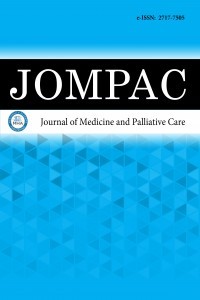Akut böbrek yetmezliğinde hiperüriseminin rolü
Hemodiyaliz, akut böbrek yetmezliği, hiperürisemi, ürik asit, yoğun bakım ünitesi
The role of hyperuricemia in acute renal failure
Acute renal failure, hemodialysis, hyperuricemia, uric acid, intensive care unit,
___
- Griffin BR, Liu KD, Teixeira JP. Critical care nephrology: core curriculum 2020. Am J Kidney Dis 2020; 75: 435-52
- Ostermann M, Zarbock A, Goldstein S, et al. Recommendations on acute kidney injury biomarkers from the acute disease quality initiative consensus conference: a consensus statement. JAMA Netw Open 2020; 3: e2019209.
- Maiuolo J, Oppedisano F, Gratteri S, Muscoli C, Mollace V. Regulation of uric asid metabolism and excreation. Int J Cardiol 2015;S0167-5273 0342-9.
- Chaudhary K, Malhotra K, Sowers J, Aroor A. Uric acid-key ingredient in the recipe for cardiorenal metabolic syndrome. Cardiorenal Med 2013; 3: 208-20.
- Yildirim A, Altinkaynak K, Aksoy H, Sahin YN, Akcay F. Plasma xantine oxidase, superoxide dismutase and glutathione peroxidase activities and uric acid levels in severe and mild pre-eclampsia. Cell Biochem Funct 2004; 22: 213-7.
- Nan H, Dong Y, Gao W, Tuomilehto J, Qiao Q. Diabetes associated with a low serum uric acid level in a general Chinese population. Diabetes Res Clin Pract 2007; 76: 68-74.
- Jhonson RJ, Perez-Pozo SE, Sautin YY, et al. Hypothesis: could excessive fructose intake and uric acid cause type 2 diabetes? Endocr Rev 2009; 30: 96-116.
- Şengül E, Binnetoğlu E, Yılmaz A. Kronik böbrek hastalarında serum ürik asit düzeyi ile glukoz, HbA1c, lipid profili, vücut kitle indeksi ve kan basıncı arasındaki ilişki. DEÜ Tıp Fakültesi Derg 2011; 25: 163-68.
- Nakagawa T, Kang DH, Feig D, et al. Unearthing uric acid: an ancient factor with recently found significance in renal and cardiovascular disease. Kidney Int 2006; 69: 1722-25.
- Sautin YY, Nakagawa T, Zharikov S, Johnson RJ. Adverse effects of the classic antioxidant uric acid in adipocytes: NADPH oxidase-mediated oxidative/nitrosative stress. Am J Physiol Cell Phsiol 2007; 293: 584-96.
- Chonchol M, Shlipak MG, Katz R, et al. Relationship of uric acid with progression of kidney disease. Am J Kidney Dis 2007; 50: 239-47.
- Wu XH, Zhang J, Wang VC, et al. Two steroidal glycosides from Smilax riparia, resist to hyperuricemia based on URAT1 in hyperuricemic mice. Phytomedicine 2014; 21: 1196-201.
- Moore PK, Hsu RK, Liu KD. Management of acute kidney injury: core curriculum 2018. Am J Kidney Dis 2018; 72: 136-48.
- Liano F, Pascual J. Epidemiology of acute renal failure: a prospective, multicenter, community-based study. The Madrid Acute Renal Failure Study Group. Kidney Int 1996; 334: 1448-60.
- Brivet FG, Kleinknecht DJ, Loirat P, Landais PJ. Acute renal failure in intensive care units-causes, outcome, and prognostic factors of hospital mortality; a prospective , multicenter study. French Study Group on Acute Renal Failure. Crit Care Med 1996; 24: 192-8.
- Silveira Santos CGD, Romani RF, Benvenutti R, et al. Acute Kidney Injury in Elderly Population: A Prospective Observational Study. Nephron 2018; 138: 104-12.
- Wu B, Li L, Cheng X, et al. Propensity-score-matched evaluation of under-recognition of acute kidney injury and short-term outcomes. Sci Rep 2018 11; 8: 15171.
- Conlon P, Stafford-Smith M, White WD, et al. Acute renal failure following cardiac surgery. Nephrol Dialys Transplant 1999; 14: 1158-62.
- Abelha FJ, Botelho M, Fernandes V, Barros H. Determinants of Postoperative Acute Kidney Injury.Crit Care 2009; 13: R79.
- Singh A, Hussain S, Kher V, Palmer AJ, Jose M, Antony B. A systematic review of cost-effectiveness analyses of continuous versus intermittent renal replacement therapy in acute kidney injury. Expert Rev Pharmacoecon Outcomes Res 2022; 22: 27-35.
- Herget-Rosenthal S, Marggraf G, Husing J, et al. Early detection of acute renal failure by serum cystatin C. Kidney Int 2004; 66: 1115-22.
- Waheed Y, Yang F, Sun D. Role of asymptomatic hyperuricemia in the progression of chronic kidney disease and cardiovascular disease. Korean J Intern Med 2021; 36: 1281-93.
- Kang DH. Hyperuricemia and progression of chronic kidney disease: role of phenotype transition of renal tubular and endothelial cells. Contrib Nephrol 2018; 192: 48-55.
- Nash K, Hafeez A, Hou S. Hospital-acquired renal insufficiency. Am J Kidney Dis 2002; 39: 930-6.
- Medve L, Antek C, Paloczi B, et al. Epidemiology of acute kidney injury in Hungarian intensive care units: a multicenter, prospective, observational study. BMC Nephrology 2011; 12: 3-7.
- Liano F, Pascual I. Epidemiology of acute renal failure: A prospective, multicenter communitybased study. Kidney Int 1996; 50: 811-8.
- Barrantes F, Feng Y, Ivanov O, et al. Acute kidney injury predicts outcomes of non-critically ill patients. Mayo Clin Proc 2009; 84: 410-16.
- Koçyiğit İ, Ünal A, Sipahioğlu MH, et al. Trends in Acute Renal Failure in Central Anatolia. Turk Neph Dial Transpl 2013; 22: 251-57.
- Başlangıç: 2020
- Yayıncı: MediHealth Academy Yayıncılık
Fatih VAROL, Yasar Yusuf CAN, Büşra ÖZGÜNAY, Mehmet CENGİZ, Ugur ALTAS, Şirin GÜVEN, Halit CAM
Melih HANGÜL, Mehmet KÖSE, Hüseyin PÜR, Murat DOĞAN, Emrah TÜRK, Ali ERSOY, Mehmet Adnan ÖZTÜRK
Murat ÖNAL, Mehmet AĞAR, Tuğba GÜRBÜZ
Delta nötrofil indeksinin aksiller metastazları belirlemede tanısal değeri
Ertugrul Gazi ALKURT, Mehmet Berksun TUTAN
Asena AYAR MADENLİ, İnci ÖZ, Tuğba GÜRBÜZ
PCO2, COVID-19 hastalarında mortalite belirteci olabilir mi?
Ülkü SİYAH, Salih CESUR, Gunay TUNCER ERTEM, Taliha KARAKÖK, Esra KAYA KILIÇ, Cigdem ATAMAN HATİPOGLU, Sami KINIKLI
Ezgi EREM, Fatih Mehmet KIŞLAL
Yoğun bakım yatışı sırasında radyoterapi endikasyonu konulan hastalarda tedavi sonuçlarımız
Gonca ALTINIŞIK İNAN, İpek Pınar ARAL, Tarık KARGIOĞLU, Çağkan ERGİDEN, Yılmaz TEZCAN
Deniz ÇELİK, Murat YILDIZ, Hasret Gizem KURT, Zeynep Tilbe SAYMAZ
